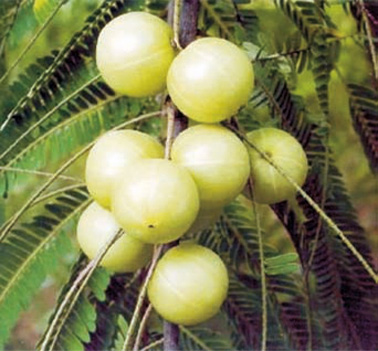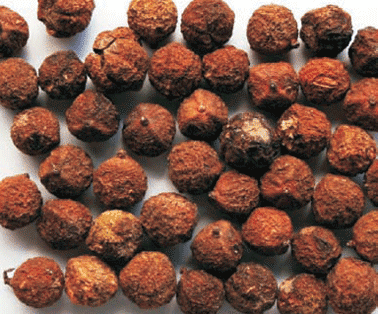|
Botanical Name:
Emblica officinalis Gaertn
AAmla consists of pericarp of dried mature fruits of Emblica
officinalis Gaertn. (Synonym Phyllanthus emblica Linn,
Family Euphorbiaceae)
Common Name(s) in English & Indian Languages
Sanskrit: Amalaka, Am¤taphala, Dhatriphala
Assamese: Amlaku, Amlakhi, Amlakhu
Bengali: Amla, Dhatri
English: Emblic Myrobalan
Guajarati: Ambala, Amala
Hindi: Amla, Aonla
Kannada: Nellikayi
Kashmiri: Embali, Amli
Malayalam: Nellikka
Marathi: Anvala, Avalkathi
Oriya: Anala, Ainla
Punjabi: Aula, Amla
Tamil: Nellikkai, Nelli
Telugu: Usirika
Urdu: Amla, Amlaj
Botanical description:
Emblica officinalis Gaertn is a small to medium sized
deciduous tree growing up to 18m in height with thin light
grey, bark exfoliating in small thin irregular flakes.
Leaves are simple, many sub sessile, closely set along the
branchlets, distichous light green having the appearance of
pinnate leaves. Flowers are greenish yellow in axillary
fascicles, unisexual; males numerous on short slender
pedicels; females few, subsessile; ovary 3-celled. Fruits
are globose, 1-5cm in diameter, fleshy, pale yellow with 6
obscure vertical furrows enclosing 6 trigonous seeds in
2-seeded 3 crustaceous cocci. Two forms Amla are generally
distinguished; the wild ones with smaller fruits and the
cultivated ones with larger fruits.
Parts used:
Fruits
Major chemical constituents:
Ascorbic acid and tannins.
Therapeutic uses:
• Bleeding disorder (Raktapitta)
• Hyperacidity (Amlapitta)
• Urinary disorder (Prameha)
• Burning sensation (Daha)
|
|


|
|
|



